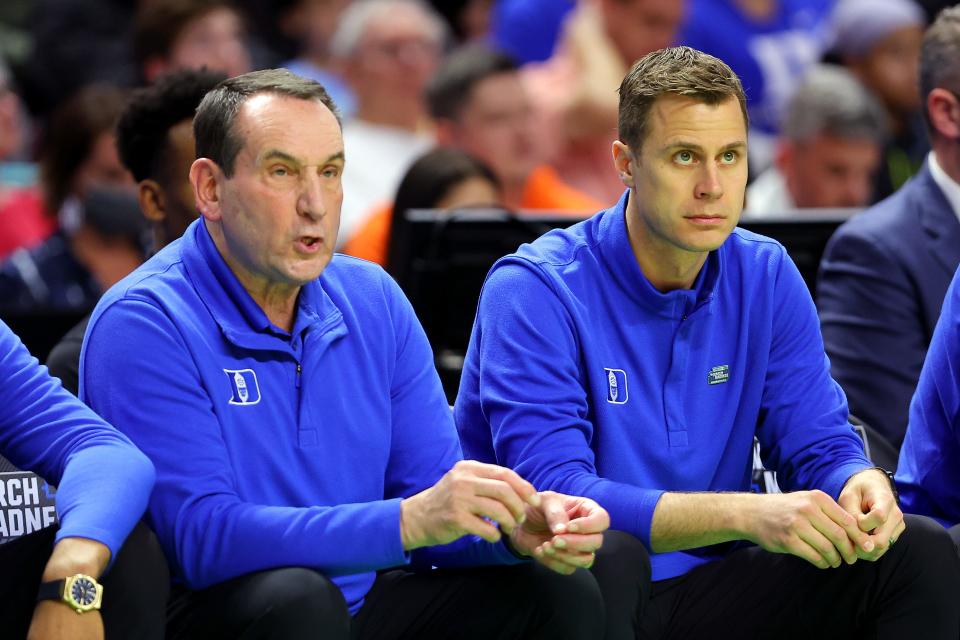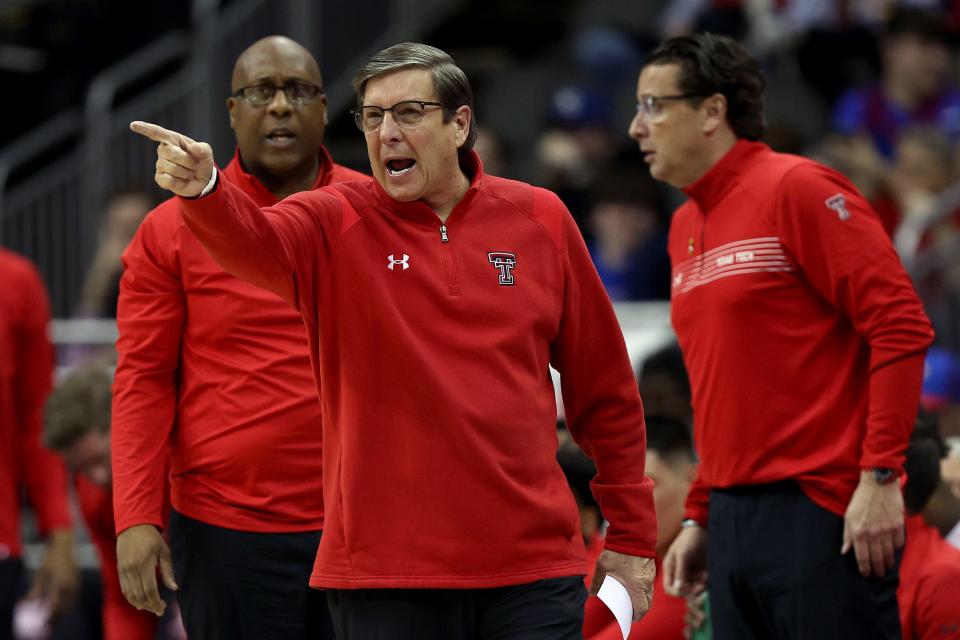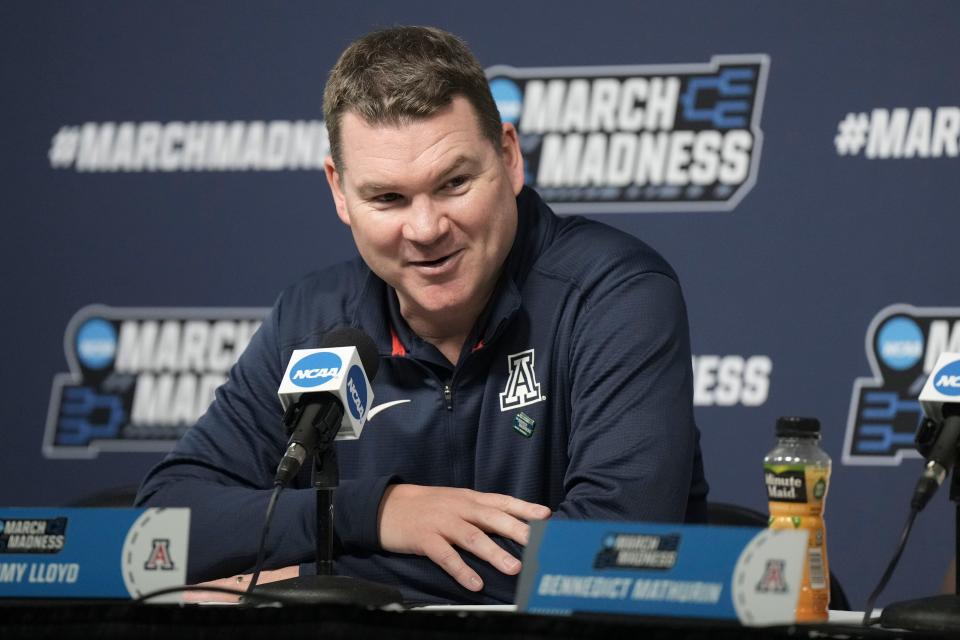'Not easy': Men's NCAA Tournament shows tradition matters in promoting assistants to head coaches
Dan Monson remembers the conversation he had with the Gonzaga athletic department and university officials about who his replacement would be in 1999.
"We were talking about having an assistant step in to be head coach, and they said, 'That's great. Now which one is Mark Few?' I still laugh at that.
"Pretty sure everyone knows who he is now."
Few’s big start as a men’s head basketball coach came as a ripple effect of Gonzaga’s program-defining Elite Eight run in 1999. A top assistant to Monson, a 36-year-old Few took over for the ‘Zags when Monson left for seemingly greener pastures at a power conference program in Minnesota.
"When you establish a winning culture at a program, the easiest and best way to keep it going is to promote an assistant up," Monson said. "Because they have the boots on the ground with recruiting and the players have that familiarity. There are some very good assistant coaches out there capable of being head coaches. But a lot of it is about timing and if a school is in the right place."
NCAA Tournament bracket: Follow March Madness
Relive Sunday's action: Winners and losers from Sunday's eight games
Stay up-to-date: Subscribe to our sports newsletter

Few went on to turn Gonzaga into a perennial contender, reaching 23 consecutive NCAA Tournaments, including two Final Fours, two Elite Eights and two Sweet 16s in the last six years. The Bulldogs have been the top overall seed in the NCAA Tournament the past two seasons.
“Everybody has to get their first chance, right?" Few said. "It was even Coach K's (first) gig at some point. There's a lot of (assistant coaches) who are ready, and to me it's about ... finding the right place and working for the right people."
In an era in which some of the greatest coaches of all time — namely Duke’s Mike Krzyzewski this year and North Carolina’s Roy Williams last year – are being ushered off into retirement, the "next-coach-up" mentality is signaling that a program’s tradition has staying power after a new coach takes over.
Jon Scheyer, at 34, will become the second youngest coach in men’s college basketball when he takes over for Krzyzewski. The youngest coach in the NCAA, Drew Valentine of Loyola-Chicago, took over for Porter Moser after he left for Oklahoma last year. Valentine then took the Ramblers back to the NCAA Tournament as a No. 10 seed.
The success stories for next coaches up are a mile high. Former UConn coach Kevin Ollie took over for Jim Calhoun in 2012 and won a national title in his second season. Greg Gard took over for Bo Ryan in 2015 and led Wisconsin to two consecutive Sweet 16s. But the expectations are just as high.

"I wouldn’t say it’s pressure I feel," Scheyer said. "It’s more just the level of responsibility because of what Coach (Krzyzewski) and Duke is all about – as a global brand in the world and how people take pride in our program. I don’t take it lightly, but at the same time it doesn’t overwhelm me.”
Mark Adams' rebuild at Texas Tech
Sometimes the school's tradition can be the perfect ingredient for a smooth transition. Take Texas Tech as a classic example. Coach Chris Beard helped elevate the Red Raiders into an elite program in five seasons, including an Elite Eight in 2018 and national runner-up finish in 2019. That prompted his move to Texas – seemingly a better job. Except Texas Tech outperformed Texas this year in every way under Mark Adams – the next man up for the job. The Red Raiders swept the Longhorns in the regular season and earned a higher seed, No. 3, than Texas' No. 5 in the NCAAs.
Much like Few with Monson in the late 1990s, Adams was Beard’s right-hand man at Arkansas Little Rock and Texas Tech. Now he has kept the Red Raiders in the national conversation. His pathway to being the next man up, however, was a long time coming. At 65, Adams coached at the Division II and junior college level and had an unsuccessful tenure as head coach at Texas-Pan American in the early 1990s.
"It hits home when I see my name in March Madness," Adams said. "To be at a university that has some tradition, has a great fan base. … that’s a great start."

It wasn’t easy once Beard left, with the transfer rule nearly decimating Texas Tech’s roster. In April last year, Adams had just four players on his roster and was tasked with rebuilding. The foundation of tradition is what made that doable, Adams said.
"The problem was it was just Coach (Sean) Sutton and I in an empty office. We had to put that staff together," Adams said. "We had the vision, look, let's put together a championship team to go along with this – we knew it would be a championship program. We didn't know it would happen this fast."
But coaching succession plans don't always pan out. Washington coach Mike Hopkins was named coach-in-waiting in 2015 to Jim Boeheim as a longtime assistant at Syracuse. But Hopkins left for Washington in 2017 and Boeheim is still coaching at 'Cuse.
At Gonzaga, Few has had multiple job opportunities at blue-blood programs but instead opted to turn Gonzaga into a powerhouse of its own. That made Tommy Lloyd's trajectory to head coach more of a waiting game of when to leave Spokane even though he was capable of taking over. Few's top assistant who stayed at Gonzaga for two decades, Lloyd finally found the right fit in Arizona. The Wildcats were the second overall No. 1 seed this season after Lloyd piloted them to a 32-3 record.
"I had a real comfort level and conviction in what I wanted to do," Lloyd said. "Everything basketball wise, I've done, basically I've been a part of doing (at Gonzaga). The biggest thing for me has been the amount of day-to-day energy."

'You still have to make it on your own'
Before Lloyd, Boise State coach Leon Rice was Few's top assistant. In his 12th season at Boise, he was just named the Mountain West Conference coach of the year after guiding the Broncos to the NCAA Tournament and an MWC tournament title.
"These guys know what they're doing, and circumstantially, it takes them a while to get going," Few said. "Harkening back to Coach K's first three years, how smart it was I think (athletic director Tom) Butters that kept him around. In this day and age, that would never happen. ... It's a matter of the athletic directors and the people hiring and understanding that there are worthy candidates out there ready for their first try at it."
And Monson, the head coach at Long Beach State for the last 15 years, remembers when that coach was Few.
"Mark had me come spend time for a travel party with the (Gonzaga) team in 2016-17. I told him it had been too long and he told me, 'This thing started brick by brick with you.' It was almost like I was in a time warp. The program is still being run like it was 25 years ago, but Mark kept everything in a bubble despite all the success. The only big difference was instead of the freshmen getting the bags off the bus, now it's the private plane."
The coaching carousel annually leads to mid-major coaches taking jobs at elite programs by capitalizing off breakthrough seasons, such as Todd Golden leaving San Francisco this month to become Florida's new head coach. And Saint Peter's Shaheen Holloway is a favorite to fill Seton Hall's coaching vacancy this offseason.
But in this new era in which elite players can transfer and have immediate eligibility, the coaches making millions of dollars are tasked even more with maintaining a culture and tradition that has staying power.
When Monson left for Minnesota in 1999, he said the tradition that was instilled at Gonzaga further blossomed under Few. That's been on display in 2021-22 with Texas Tech and Adams. Soon it will be Scheyer's challenge at Duke when Krzyzewski retires.
"You're not trying to completely replicate what a former coach has done," Monson said. "You still have to make it your own. Whenever you follow a legend, it's not easy. It hasn't been easy for any coach at UCLA because of what John Wooden did. But at a place like Duke, you can rely on the tradition and culture."
Follow college basketball reporter Scott Gleeson on Twitter @ScottMGleeson.
This article originally appeared on USA TODAY: March Madness shows tradition matters in assistants' rise to top job

